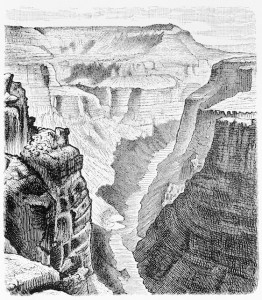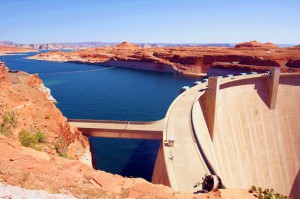
The Colorado River is, arguably, one of the most talked about river systems in the world. With approximately 30 million people depending on it for water and irrigation, hundreds of species of animals and plant life making it their habitat and managed by two of the largest dams in the country, the Colorado River has been an influential part of our nation’s history for centuries.
Native Americans Settle Along the River
We know the Paleo-Indians were the first known human inhabitants of the Grand Canyon, but who inhabited the area along the Colorado River? According to the National Geological Survey, the earliest known settlers in the Colorado River basin were the Hohokan, a prehistoric population of people who disappeared from the continent’s historical landscape even before the storied Hopi and Pueblo Indians inhabited the area. They think the Apache and Navajo peoples came around the 13th century.
A Powerhouse Flows Red
Because the surrounding areas are made up of sediment rock, the land stood little chance against the forceful, fast-flowing waters of the Colorado River. Over time, the river ate away huge chunks of each and rock, carrying tons of sediment with it. The original river, prior to the creation of dams, was red with sediment and was undrinkable, unusable and unable to support plant or animal life at its shores. Its volume and temperature varied dramatically each season creating an inhospitable environment that a select number of fish and plant species adapted to. This, in turn, created an exclusive ecosystem perfectly suited for life in and around the Colorado River and could be found nowhere else on earth.
The Exploration of a Wild River
While there had been several attempts at exploring the Colorado River, deep inside the Grand Canyon, no one was able to do it until John Wesley Powell did in 1869. A young, 30-something professor of natural history with a penchant for adventure, Powell gathered a crew of nine men and set out to explore the Colorado River and its surrounding landscape. They followed a route along the Colorado River Plateau, known for its high altitude.
The brave crew began their trek in the Wyoming Territory, at Green River Station. Powell lost 4 crewmen along the way: one bowed out six weeks into the expedition and three were killed by natives after wandering off, just two days shy of the conclusion of the journey.
Powell and his remaining men emerged from the river three months later, having successfully navigated one of the most treacherous rivers in the world.
Industrialization of the Colorado River
For centuries, the Colorado River roared, uninterrupted through the Canyon’s landscape until people began thinking it could be used to benefit a growing population.
The industrialization of the Colorado River began over 200 years ago in the early 1800’s, with limited success. It was clear, the river’s strength and volume could and should be used. Channels cut in the early 20th century diverted water to dry land creating agricultural possibilities where none existed previously. But the water flow was too strong to contain it and the experiment failed.

In 1963, construction was successfully completed on the Glen Canyon Dam along the Arizona/Utah boarder, halting the thick, reddish sediment and allowing the river, for the first time, to flow with clear waters. The Glen Canyon Dam slowed the flow rate of the river through the Grand Canyon and helped prevent silt from building up behind the Hoover Dam, at the other side of the Grand Canyon.
The Building of a Modern Marvel
With its numerous plans and failed attempts to harness the Colorado River, came the construction of a dam lauded by many as the saving grace of the Grand Canyon – the Hoover Dam. Built during the Depression, thousands of people worked to erect the largest dam in the world at that time. It took five years to complete the project that successfully regulated water flow and harnessed the power of the river to produce electricity. Today, the Hoover Dam is considered a modern marvel, with more than 1 million visitors a year. It was named one of the Top 10 Achievements of the 20th Century and is a National Historic Landmark.
According to the U.S. Department of the Interior, the Hoover Dam generates, on average, about 4 billion kilowatt-hours of hydroelectric power every year. This serves approximately 1.3 million people across California, Arizona and Nevada, all thanks to the powerful Colorado River. Implementation of the Hoover Dam changed the river and the canyon forever.
A River Changed; An Environment Taxed
Just like anything altering nature, the completion of the Glen Canyon Dam affected the ecological make up of the Grand Canyon. The water temperature, which, historically, reached 80 degrees Fahrenheit, were remaining icy-cold year round, around 42 degrees Fahrenheit. Fish that thrived in the warmer water soon became extinct, altering the wildlife composition of the waters. One species that thrived in the colder waters was the Rainbow Trout, a non-native species.
Erecting the Hoover Dam produced similar changes to the surrounding ecosystems, harming the delicate landscape, while promoting the survival of others – often man-introduced species. It’s a delicate story of survival – with progress, many species have lost their habitat and many have become extinct. Many others are at the brink of extinction. Conversely, thanks to the evening of the flow of water and the new clarity and temperature created by the dams, many new species have begun to flourish. The river has created plant life along its shores attracting many animals that are now also able to use it as a water source. The loss of one habitat has created another, rich in different ways than the original, but rich, nonetheless.
There is little doubt the success of Hoover Dam spurned other projects; leading to what many would say is an overtaxing of the Colorado due to the ever-increasing demands of modern society. Rising sediment in Lake Powell and Lake Mead are issues that need to be addressed in coming years as will solutions for growing populations needing more energy than the dams can support.